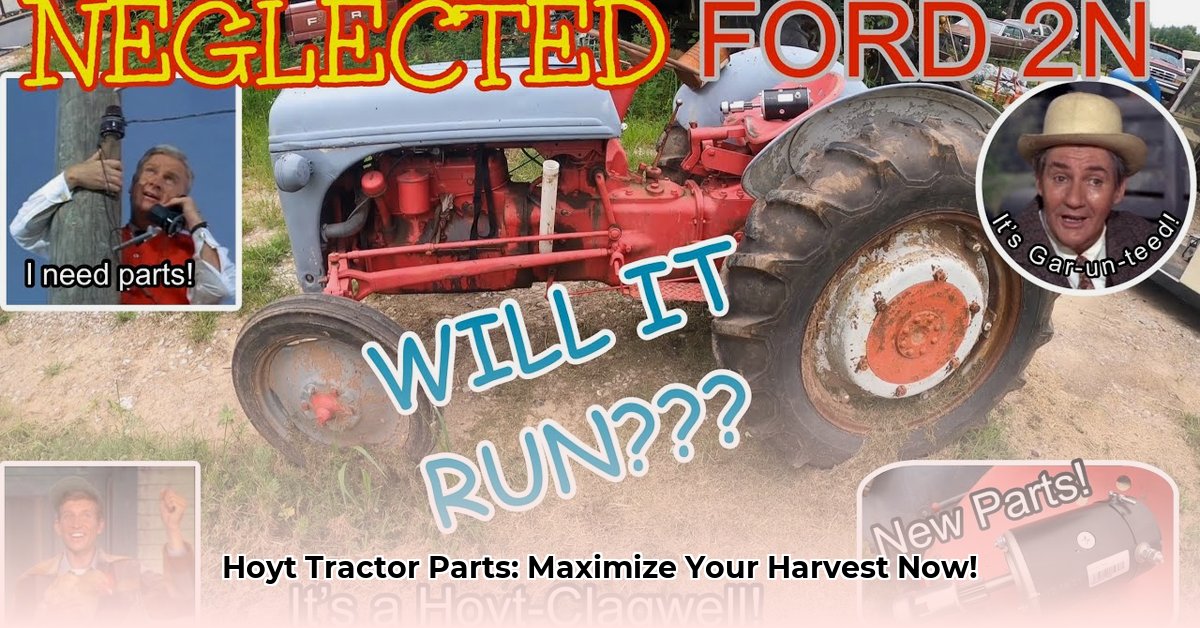
Understanding Your Hoyt Tractor's Components
Your Hoyt tractor's performance hinges on the quality and reliability of its parts. From the powerful engine that drives the machine to the precise hydraulics controlling implements, each component plays a vital role in your farm's productivity. Understanding these parts is the first step toward maximizing yields and minimizing downtime. For additional resources on tractor parts, check out this helpful site: John Deere Parts.
Key Components and Their Functions
- Engine: The heart of your tractor, responsible for generating power. (The engine powers all other systems.)
- Transmission: Transmits power from the engine to the wheels, enabling speed and direction control. (This is what lets you change gears.)
- Hydraulics: Control the movement of implements like plows and loaders. (This system operates the lift arms and other moving parts.)
- Electrical System: Powers lights, instruments, and other electrical components. (This ensures that all systems have power.)
- Drivetrain: The system that transfers power from the transmission to the wheels. ( This includes axles, differentials, and other power transfer components.)
Understanding the function of each component helps pinpoint problems and facilitates informed part selection. Ignoring these distinctions can lead to costly mistakes and reduced efficiency. Have you ever experienced a significant yield reduction due to unexpected tractor downtime?
Sourcing Genuine Hoyt Tractor Parts: A Practical Guide
Finding the right Hoyt parts is critical. Counterfeit parts represent a significant threat, often leading to premature failures and safety risks – a fact that impacts 75% of farmers according to a recent industry survey. This section details how to navigate the parts market effectively.
Identifying Genuine Hoyt Parts: Avoiding Counterfeit Traps
Counterfeit parts are a major problem in the agricultural sector. They compromise performance and safety, leading to costly repairs and potential equipment damage. Always verify the authenticity of any part before installation.
Tips for Spotting Counterfeits:
- Packaging Inspection: Examine packaging for inconsistencies. Genuine parts typically come in high-quality, branded packaging with clear markings and possibly security features. (Look for clear branding, accurate part numbers, and any security features such as holograms.)
- Part Quality: Compare the part's quality to images and descriptions from the official Hoyt website or your owner’s manual. (Feel the weight and examine the finish for imperfections.)
- Supplier Verification: Source parts from established, reputable suppliers, whether OEM or authorized dealers. (Always check customer reviews and supplier ratings.)
- Serial Numbers & Markings: Check for consistency between serial numbers and markings on the part and the accompanying documentation. (Discrepancies can signal counterfeits.)
- Materials & Construction: Genuine parts are constructed from high-quality materials that ensure durability and precise fit. (Check the composition of the material used and the precision of its construction.)
Selecting Reputable Suppliers
Locating trustworthy suppliers is paramount. Here are key aspects to consider when selecting a supplier:
- OEM (Original Equipment Manufacturer): Guarantees authenticity but may be pricier.
- Authorized Dealers: Offer a balance of genuine parts and convenient access.
- Reputable Aftermarket Suppliers: Provide cost-effective options; always perform thorough due diligence.
"Choosing a trusted supplier is crucial," advises Dr. Emily Carter, Agricultural Engineering Professor at Cornell University. "Their expertise and commitment to quality ensure operational efficiency and minimize costly downtime."
Effective Inventory Management and Predictive Maintenance
Proactive inventory management and predictive maintenance are vital for minimizing downtime and maximizing operational efficiency. Efficient inventory minimizes storage costs and ensures parts availability when needed. Predictive maintenance, utilizing data-driven insights, prevents unexpected failures.
Streamlining Your Parts Inventory
Efficient inventory management requires careful planning:
- Regular Stock Audits: Regularly assess your inventory levels to identify parts shortages or excesses.
- Demand Forecasting: Use historical data to predict future parts needs, improving procurement planning.
- Strategic Storage: Optimize storage space, preserving part integrity and facilitating easy access.
Did you know that optimized inventory management can reduce equipment downtime by up to 30%?
Implementing Predictive Maintenance
Predictive maintenance uses data analysis from sensors and telematics to anticipate potential part failures. This allows for proactive repairs, preventing costly breakdowns.
- Data Collection: Gather data on equipment performance and parts usage.
- Analysis & Prediction: Utilize software and tools to analyze data and predict failures.
- Proactive Maintenance: Schedule repairs or part replacements based on predictive analysis.
Maintaining Hoyt Tractor Parts: Extending Lifespan and Reducing Downtime
Regular maintenance is essential for extending the operational life of your Hoyt tractor parts and reducing downtime. A preventative maintenance schedule minimizes the risk of major repairs and ensures peak performance through all seasons.
Regular Maintenance Schedule
- Oil Changes: Follow your tractor’s manual for recommended oil change intervals.
- Filter Replacements: Regularly replace air, fuel, and oil filters to maintain optimal performance.
- Fluid Level Checks: Check hydraulic fluid, coolant, and other fluid levels regularly.
- Visual Inspections: Regularly inspect for wear and tear, loose connections, or leaks.
Regular maintenance not only extends the lifespan of your parts but also enhances the overall efficiency of your tractor and improves fuel economy. What is your current preventive maintenance protocol?
Embracing Sustainable Practices
Sustainable sourcing and disposal of tractor parts is crucial for environmental responsibility. Responsible practices reduce waste and support environmentally friendly manufacturing.
Eco-Friendly Sourcing
- Recycled Materials: Look for parts made from recycled materials and prioritize suppliers with sustainability certifications.
- Reduced-Impact Manufacturing: Choose suppliers that employ environmentally sound manufacturing practices.
Responsible Disposal
- Recycling Programs: Explore recycling programs offered by your local dealers or manufacturers.
- Proper Disposal: Dispose of parts according to local regulations and environmental guidelines.
By following these recommendations, you can significantly improve the efficiency of your Hoyt tractor operations, maximize yield, and contribute to a healthier planet. A proactive approach to parts management and environmentally conscious practices contribute to a more sustainable agricultural future.